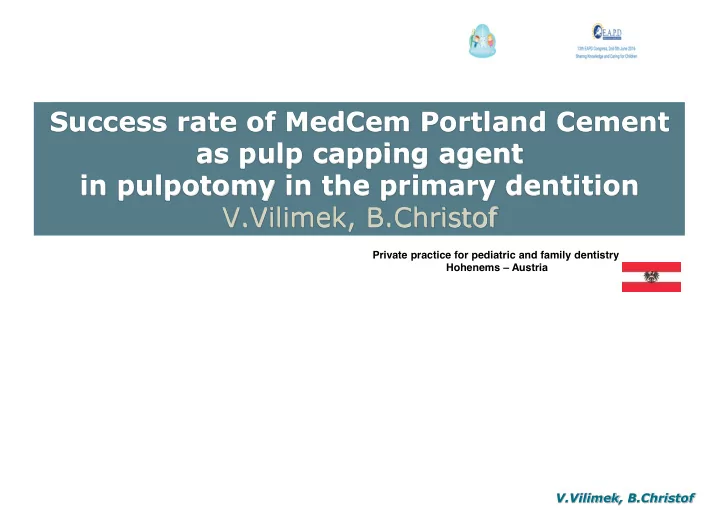

Success rate of MedCem Portland Cement as pulp capping agent in pulpotomy in the primary dentition V.Vilimek, B.Christof Private practice for pediatric and family dentistry Hohenems – Austria V.Vilimek, B.Christof
Pulpotomy in primary dentition � Is the treatment of choice in cases (AAPD 2012-2013): Reversible pulpits � When caries removal results in pulp exposure � After traumatic exposure � V.Vilimek, B.Christof
Pulpotomy in primary dentition The success of the therapy depends on: Correct diagnosis of the inflamed dental pulp. � Selection of biocompatible and bio-inductive material � Recently, great interest has been focused on the evolution of � Portland cement (PC) as an alternative to MTA. V.Vilimek, B.Christof
Pulpotomy in primary dentition AIM: • To evaluate the clinical and radiographic outcomes of Portland cement (PC) as pulp capping agent in primary teeth pulpotomies. V.Vilimek, B.Christof
Material and Methods: The study included: • 71 primary teeth (9 incisors and 62 molars) of 20 girls and boys (ASA 1) aged 3-8 years • With deep carious lesions: o Presenting a potential risk of pulp exposure during treatment. o With symptoms of inflammation of the coronal pulp. V.Vilimek, B.Christof
Material and Methods: Excluded from the study: • Clinical criteria: • Spontaneous pain. • Mobility. • Radiographic criteria: • Fistula. • Teeth with more than 2/3 root • Abscess (gingival redness and swelling). resorption. • Periodontal ligament widening. • Systemic diseases. • Periodontal and furcation bone resorption V.Vilimek, B.Christof
METHODS : Pulpotomy in primary dentition Treatment was performed under general anesthesia and with the technique of vital amputation. V.Vilimek, B.Christof
METHODS : Pulpotomy in primary dentition The pulp chamber was opened with a high-speed, water cooled diamond bur. Followed by removal of the entire coronal pulp with a low speed, round carbide bur. The pulp chamber was rinsed with a sterile saline. Sterile cotton pellets were applied to the pulp chamber for 2 min to control hemorrhage upon successful hemostasis. MedCem Portland Cement (PC) was used as pulp capping agent. Over the PC GIC ( Ketac Cem radio pac) was placed . The teeth were finally restored: • Incisors with composite • Molars with stainless steel crowns . V.Vilimek, B.Christof
Follow up : • Clinical and radiographic successes and failures were recorded at 3, 6, 12, 18 and 24-month follow-up. • Radiographic success was considered : • Presence of hard tissue barrier formation (HTB). • Pulp calcifications (PC). • Absence of internal or external root resorption (R). • Furcation radiolucency (FRL). V.Vilimek, B.Christof
Follow up : • Clinical and radiographic successes and failures were recorded at 3, 6, 12, 18 and 24-month follow-up. • Criteria to determine failure : • Spontaneous pain (SP). • Swelling (Sw). • Abscess (gingival redness and swelling). • Sensitivity to percussion. • Mobility (M). • Fistula (F). • Periodontal ligament widening. • Periodical and furcation bone resorption (RR). V.Vilimek, B.Christof
Results: N* Clinical criteria x-Ray criteria Total Mth SP M, Sw , F R HTB PC RR FRL S* F* N = 70 1 1 Sw, F 3 mth N= 1 69 2 6 mth N= 12 mth N= 1 – Sw 67 4 18 mth 1 - F N= 1 66 5 24 mth * N – number of teeth, *S – success, *F – failure SW = Swelling F= Fistula Furcation radiolucency = FRL Periodical and furcation bone resorption = RR V.Vilimek, B.Christof
Results: Meas ure S rate 95% CI LB 95% CI UB Group S rate diff test - p 3m 98.59% 92.40% 99.97% 6m 97.18% 90.19% 99.66% > 0.05 12m 97.18% 90.19% 99.66% 18m 94.37% 86.19% 98.45% 24m 92.96% 84.31% 97.68% 3 m 12 m 24 m (р>0,05) V.Vilimek, B.Christof
Results After 3 months the treatment of 70 teeth or 98.59% was assessed as successful. The confidence level is between 92.4 % to 99.97% - After 12 months 69 teeth (97.18 % ) were assessed as successfully treated. After 24 months the treatment of 66 teeth (92.96%) was defined as successful. The difference between the treatment in the beginning 98.59% and in the end 92.96% is statistically not significant. That means the success of 92.96 % after 24 months does not differ to the success after 3 months 98.59%. As to be seen our result showed the success rate of pulpotomies using Mec Cem Portland Cement as pulp agent in primary dentition during the observation period of a 2 years follow up.
Results after pulpotomy with PC Successful treatment even after 24 months ! After 12 months After 24 months Before Treatment 51 after 6 Months of treatment After 18 months crowns were replaced
Results after pulpotomy with PC Before Treatment • Failure after 12 months of treatment tooth 75 showed up internal resorption, no fistula, no abscess, After 12 months no pain • Failure after 24 months of treatment tooth 75 showed up full root resorption and tooth 74 a crown lost and root resorption After 24 months
Pulpotomy in primary dentition CONCLUSION: • Portland Cement may serve as an effective and inexpensive material in primary teeth pulpotomies. • Further studies and longer follow-up assessments are needed. V.Vilimek, B.Christof
Pulpotomy in primary dentition CONCLUSION: According to the achieved results, we recommend Portland Cement Med Cem as a successful pulp agent V.Vilimek, B.Christof
Recommend
More recommend